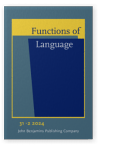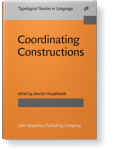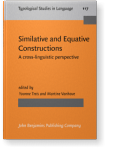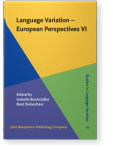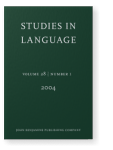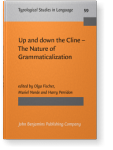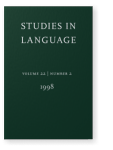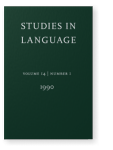Martin Haspelmath
List of John Benjamins publications for which Martin Haspelmath plays a role.
Journals
ISSN 0378-4177 | E-ISSN 1569-9978
Book series
Title
Coordinating Constructions
Edited by Martin Haspelmath
[Typological Studies in Language, 58] 2004. xcv, 576 pp.
Subjects Semantics | Syntax | Theoretical linguistics | Typology
2021 Chapter 2. Towards standardization of morphosyntactic terminology for general linguistics Linguistic Categories, Language Description and Linguistic Typology, Alfieri, Luca, Giorgio Francesco Arcodia and Paolo Ramat (eds.), pp. 35–58 | Chapter
This paper proposes that just like phonologists, linguists working on morphosyntax should have a core set of standard terms that are understood in exactly the same way across the discipline. Most of these terms are traditional terms that are given a standard retro-definition, because linguists… read more
2020 The structural uniqueness of languages and the value of comparison for language description Asian Languages and Linguistics 1:2, pp. 346–366 | Miscellaneous
This paper shows why it is not a contradiction to say that each language is structurally unique and must be described with its own categories, but language description profits enormously from typological knowledge. It has sometimes been suggested that the Boasian imperative (“each language should… read more
2018 Baker, Mark. 2015. Case Studies in Language 42:2, pp. 474–486 | Review
2017 Chapter 1. Equative constructions in world-wide perspective Similative and Equative Constructions: A cross-linguistic perspective, Treis, Yvonne and Martine Vanhove (eds.), pp. 9–32 | Chapter
In this paper, we report on a world-wide study of equative constructions (‘A is as big as B’) in a convenience sample of 119 languages. From earlier work, it has been known that European languages often have equative constructions based on adverbial relative pronouns that otherwise express degree… read more
2017 Analytic and synthetic: Typological change in varieties of European languages Language Variation - European Perspectives VI: Selected papers from the Eighth International Conference on Language Variation in Europe (ICLaVE 8), Leipzig, May 2015, Buchstaller, Isabelle and Beat Siebenhaar (eds.), pp. 3–22 | Chapter
It has long been observed that the modern European languages use more function words compared to earlier inflectional patterns, and this trend seems to have increased even further in creoles and other non-standard varieties. Here we make two arguments: First, we note that the terms synthetic and… read more
2016 Identifying semantic role clusters and alignment types via microrole coexpression tendencies Advances in Research on Semantic Roles, Kittilä, Seppo and Fernando Zúñiga (eds.), pp. 27–49 | Article
In this chapter, we illustrate a method for identifying clusters of semantic roles by cross-linguistic comparison. On the basis of data from 25 languages drawn from the ValPaL (Valency Patterns Leipzig) database, we show how one can visualize coexpression tendencies using quantitative methods (in… read more
2014 Identifying semantic role clusters and alignment types via microrole coexpression tendencies Advances in research on semantic roles, Kittilä, Seppo and Fernando Zúñiga (eds.), pp. 463–484 | Article
In this paper, we illustrate a method for identifying clusters of semantic roles by cross-linguistic comparison. On the basis of data from 25 languages drawn from the ValPaL (Valency Patterns Leipzig) database, we show how one can visualize coexpression tendencies using quantitative methods (in… read more
2012 Borrowability and the notion of basic vocabulary Quantitative Approaches to Linguistic Diversity: Commemorating the centenary of the birth of Morris Swadesh, Wichmann, Søren and Anthony P. Grant (eds.), pp. 35–55 | Article
This paper reports on a collaborative quantitative study of loanwords in 41 languages, aimed at identifying meanings and groups of meanings that are borrowing-resistant. We find that nouns are more borrowable than adjectives or verbs, that content words are more borrowable than function words, and… read more
2010 Borrowability and the notion of basic vocabulary Quantitative Approaches to Linguistic Diversity: Commemorating the centenary of the birth of Morris Swadesh, Wichmann, Søren and Anthony P. Grant (eds.), pp. 226–246 | Article
This paper reports on a collaborative quantitative study of loanwords in 41 languages, aimed at identifying meanings and groups of meanings that are borrowing-resistant. We find that nouns are more borrowable than adjectives or verbs, that content words are more borrowable than function words, and… read more
2008 Ditransitive constructions: Towards a new Role and Reference Grammar account? Investigations of the Syntax–Semantics–Pragmatics Interface, Van Valin Jr., Robert D. (ed.), pp. 75–100 | Article
This paper reviews some of basic argument marking properties of ditransitive constructions and asks how various syntactic frameworks deal with them. In particular, I critically examine two accounts within Role and Reference Grammar (RRG). I lay out a basic typology of three alignment types:… read more
2008 Parametric versus functional explanations of syntactic universals The Limits of Syntactic Variation, Biberauer, Theresa (ed.), pp. 75–107 | Article
This paper compares the generative principles and parameters approach to explaining syntactic universals to the functional-typological approach and also discusses the intermediate approach of Optimality Theory. It identifies some fundamental differences between generative parametric explanations… read more
2008 Leipzig fourmille de typologues: Genitive objects in comparison Case and Grammatical Relations: Studies in honor of Bernard Comrie, Corbett, Greville G. and Michael Noonan (eds.), pp. 149–166 | Article
In this paper we examine genitive objects in some of the major European languages (French, Italian, Latin, German, English) and propose a semantic invariant for them: We claim that in the great majority of cases, the genitive object can be said to express a background theme, i.e., a participant… read more
2007 Does linguistic explanation presuppose linguistic description? What Counts as Evidence in Linguistics: The case of innateness, Penke, Martina and Anette Rosenbach (eds.), pp. 81–107 | Article
I argue that the following two assumptions are incorrect: (i) The properties of the innate Universal Grammar can be discovered by comparing language systems, and (ii) functional explanation of language structure presupposes a “correct”, i.e. cognitively realistic, description. Thus, there are two… read more
2007 50. Comments Reciprocal Constructions, Nedjalkov, Vladimir P. (ed.), pp. 2087–2115 | Chapter
2007 Ditransitive alignment splits and inverse alignment Ditransitivity, Siewierska, Anna and Willem B. Hollmann (eds.), pp. 79–102 | Article
This paper argues that language-particular restrictions on ditransitive constructions are best understood as instantiations of easily falsifiable implicational universals that can be explained functionally, rather than as falling out from a restrictive formal metalanguage. Well-known restrictions… read more
2007 Author’s response What Counts as Evidence in Linguistics: The case of innateness, Penke, Martina and Anette Rosenbach (eds.), pp. 113–115 | Article
2004 Author’s response What Counts as Evidence in Linguistics?: The case of innateness, Penke, Martina and Anette Rosenbach (eds.), pp. 584–586 | Article
2004 1. Coordinating constructions: An overview Coordinating Constructions, Haspelmath, Martin (ed.), pp. 3–39 | Chapter
1.Coordination: Basic concepts and terms
1.1 Coordination
1.2 Basic patterns
1.3 Semantic types of coordination
2. The position of the coordinator(s)
3. Category-sensitivity of coordinating constructions
4. Semantic distinctions in conjunction
5. From comitative to conjunctive… read more
2004 Review of Aikhenvald & Dixon (2001): Areal diffusion and genetic inheritance Studies in Language 28:1, pp. 209–223 | Review article
2004 On directionality in language change with particular reference to grammaticalization Up and down the Cline – The Nature of Grammaticalization, Fischer, Olga, Muriel Norde and Harry Perridon (eds.), pp. 17–44 | Article
2004 Does linguistic explanation presuppose linguistic description? What Counts as Evidence in Linguistics?: The case of innateness, Penke, Martina and Anette Rosenbach (eds.), pp. 554–579 | Article
I argue that the following two assumptions are incorrect: (i) The properties of the innate Universal Grammar can be discovered by comparing language systems, and (ii) functional explanation of language structure presupposes a “correct”, i.e. cognitively realistic, description. Thus, there are two… read more
2001 Non-canonical marking of core arguments in European languages Non-canonical Marking of Subjects and Objects, Aikhenvald, Alexandra Y., R.M.W. Dixon and Masayuki Onishi (eds.), pp. 53–84 | Article
1999 External Possession in a European Areal Perspective External Possession, Payne, Doris L. and Immanuel Barshi (eds.), pp. 109–136 | Article
1998 Does Grammaticalization Need Reanalysis? Studies in Language 22:2, pp. 315–351 | Article
1998 The Semantic Development of Old Presents: New Futures and Subjunctives Without Grammaticalization Diachronica 15:1, pp. 29–62 | Article
SUMMARY This paper discusses a pattern of change whereby present indicative forms of verbs develop into futures and subjunctives as a side effect of a grammati-calization change consisting in the creation of a new present indicative form from a looser progressive (or other aspectual) construction.… read more
1996 Lazard, Gilbert. L'actance Studies in Language 20:3, pp. 717–719 | Squib
1994 Passive Participles across Languages Voice: Form and Function, Fox, Barbara A. and Paul J. Hopper (eds.), pp. 151–178 | Article
1993 More on the typology of inchoative/causative verb alternations Causatives and Transitivity, Comrie, Bernard and Maria Polinsky (eds.), pp. 87–120 | Article
1992 Review of Nedjalkov (1988): Typology of resultative constructions Studies in Language 16:1, pp. 240–248 | Review
1991 Review of Xrakovskij (1989): Tipologija iterativnyx konstrukcij Studies in Language 15:2, pp. 494–499 | Review
1990 The Grammaticization of Passive Morphology Studies in Language 14:1, pp. 25–72 | Article
